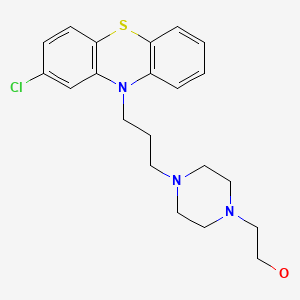Attribution Statement: LactMed is a registered trademark of the U.S. Department of Health and Human Services.
NCBI Bookshelf. A service of the National Library of Medicine, National Institutes of Health.
Drugs and Lactation Database (LactMed®) [Internet]. Bethesda (MD): National Institute of Child Health and Human Development; 2006-.
CASRN: 58-39-9

Drug Levels and Effects
Summary of Use during Lactation
Limited information indicates that maternal doses of perphenazine up to 24 mg daily produce low levels in milk. Very limited long-term follow-up data indicate no adverse developmental effects when other phenothiazines are used alone. Monitor the infant for excessive drowsiness during breastfeeding and for developmental milestones, especially if other antipsychotics are used concurrently.
Drug Levels
Maternal Levels. Steady-state perphenazine milk levels were measured in one woman while she was taking perphenazine at two different dosages. At a dose of 12 mg every 12 hours (480 mcg/kg daily) the drug concentration in a 24-hour milk collection was 3.2 mcg/L. At a dose of 8 mg every 12 hours, the average milk concentration in each of two 12-hour collection periods was 2.1 mcg/L. Milk was collected at this dosage in three 4-hour collection periods. Levels in fractionated 4-hour periods were as follows: 0 to 4 hours: 1.8 mcg/L; 4 to 8 hours: 3.1 mcg/L; and 8 to 12 hours: 2 mcg/L. The authors calculated that the breastfed infant would receive 0.1% of the maternal weight-adjusted dosage.[1]
Infant Levels. Relevant published information was not found as of the revision date.
Effects in Breastfed Infants
One infant was breastfed from 1 month to 4.5 months of age during maternal intake of perphenazine 16 mg daily. The infant grew normally and no adverse drug effects were seen.[1]
Effects on Lactation and Breastmilk
Galactorrhea has been reported with perphenazine.[2,3] Hyperprolactinemia appears to be the cause of the galactorrhea.[4-6] The hyperprolactinemia is caused by the drug's dopamine-blocking action in the tuberoinfundibular pathway. [7][7] The prolactin level in a mother with established lactation may not affect her ability to breastfeed.
Alternate Drugs to Consider
References
- 1.
- Olesen OV, Bartels U, Poulsen JH. Perphenazine in breast milk and serum. Am J Psychiatry. 1990;147:1378–9. [PubMed: 2400007]
- 2.
- Basler RS, Lynch PJ. Black galactorrhea as a consequence of minocycline and phenothiazine therapy. Arch Dermatol. 1985;121:417–8. [PubMed: 4038862]
- 3.
- Hooper JH Jr, Welch VC, Shackelford RT. Abnormal lactation associated with tranquilizing drug therapy. JAMA. 1961;178:506–7. [PubMed: 14448766]
- 4.
- Turkington RW. Prolactin secretion in patients treated with various drugs: Phenothiazines, tricyclic antidepressants, reserpine, and methyldopa. Arch Intern Med. 1972;130:349–54. [PubMed: 4560178]
- 5.
- Turkington RW. Serum prolactin levels in patients with gynecomastia. J Clin Endocrinol Metab. 1972;34:62–6. [PubMed: 5061776]
- 6.
- Meltzer HY, Fang VS. The effect of neuroleptics on serum prolactin in schizophrenic patients. Arch Gen Psychiatry. 1976;33:279–86. [PubMed: 1259521]
- 7.
- Maguire GA. Prolactin elevation with antipsychotic medications: Mechanisms of action and clinical consequences. J Clin Psychiatry. 2002;63 Suppl 4:56–62. [PubMed: 11913677]
Substance Identification
Substance Name
Perphenazine
CAS Registry Number
58-39-9
Disclaimer: Information presented in this database is not meant as a substitute for professional judgment. You should consult your healthcare provider for breastfeeding advice related to your particular situation. The U.S. government does not warrant or assume any liability or responsibility for the accuracy or completeness of the information on this Site.
- User and Medical Advice Disclaimer
- Drugs and Lactation Database (LactMed) - Record Format
- LactMed - Database Creation and Peer Review Process
- Fact Sheet. Drugs and Lactation Database (LactMed)
- Drugs and Lactation Database (LactMed) - Glossary
- LactMed Selected References
- Drugs and Lactation Database (LactMed) - About Dietary Supplements
- Breastfeeding Links
- PubChem SubstanceRelated PubChem Substances
- PubMedLinks to PubMed
- Review Fluphenazine.[Drugs and Lactation Database (...]Review Fluphenazine.. Drugs and Lactation Database (LactMed®). 2006
- Review Chlorpromazine.[Drugs and Lactation Database (...]Review Chlorpromazine.. Drugs and Lactation Database (LactMed®). 2006
- Review Prochlorperazine.[Drugs and Lactation Database (...]Review Prochlorperazine.. Drugs and Lactation Database (LactMed®). 2006
- Review Trifluoperazine.[Drugs and Lactation Database (...]Review Trifluoperazine.. Drugs and Lactation Database (LactMed®). 2006
- Review Flupenthixol.[Drugs and Lactation Database (...]Review Flupenthixol.. Drugs and Lactation Database (LactMed®). 2006
- Perphenazine - Drugs and Lactation Database (LactMed®)Perphenazine - Drugs and Lactation Database (LactMed®)
Your browsing activity is empty.
Activity recording is turned off.
See more...
